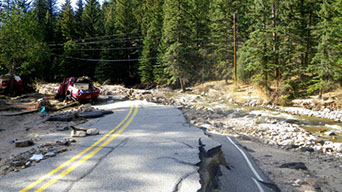

Website Contact:
Email Web Manager


FOIA
Accessibility Statement
Non-Discrimination Statement
Information Quality
USDA Press Releases
USA.gov
Biological and
Physical Resources
Updated: 08/26/2024
Flood Potential
Greater insight into the expected magnitudes and spatial variability of riverine floods is needed to effectively manage our stream valley resources and build more sustainable communities. Traditional approaches for understanding and quantifying flood hazards have not substantially evolved despite concerns regarding increased flood severity in a changing climate. Hazards can also be poorly communicated by technical specialists to decision makers and the public, with more concise language and tools needed. With innovative use of the observational record, the flood potential method was developed to assist with these challenges.
This analysis approach uses a space-for-time substitution to predict expected large flood magnitudes given the  streamgage record in nearby watersheds, in zones of similar flood response. Regressions of record peak discharges for streamgages across each zone define the expected flood potential, with high explained variance (average R2 = 0.93). The 90% prediction limit defines the maximum likely flood potential, with discharges above this being extreme and departure indicating the degree of extremity.
streamgage record in nearby watersheds, in zones of similar flood response. Regressions of record peak discharges for streamgages across each zone define the expected flood potential, with high explained variance (average R2 = 0.93). The 90% prediction limit defines the maximum likely flood potential, with discharges above this being extreme and departure indicating the degree of extremity.
From these zonal regressions, indices were developed to test for trends in the magnitudes, frequency, and flashiness of large floods, and to facilitate the comparison of flooding characteristics across regions and continents to help understand and communicate about flood hazards and how they vary.
Flood Potential Portal: https://floodpotential.erams.com
Flood Potential Method Support Page: https://y-water.com/floodpotential/
The Flood Potential Portal (FPP) is a decision support system developed, in part, to serve the results of these analyses through a map-based interface. This tool was developed as a collaboration between the One Water Solutions Institute at Colorado State University and the Forest Service National Stream and Aquatic Ecology Center. For continental through catchment scales, the FPP provides practitioners enhanced understanding of flood hazards, highlighting flood variability over space and time, and quantifying flood magnitudes for user-selected watersheds. The Flood Potential Portal provides a one-stop shop for flood prediction, including a module for computing flood potential, index flood frequency, and regional regression flood frequency (StreamStats) discharge predictions for quantifying design flood discharges, as well as a module for computing streamgage flood-frequency analyses.
Detailed instructions on using this tool are available at:
- Flood Potential Portal: User Manual
- Flood Potential Portal: Quick Start Guide
For additional information on the flood potential method, contact Steven Yochum, Hydrologist, USDA Forest Service, National Stream and Aquatic Ecology Center.
The currently available analysis extent is shown below (with flood potential index values: warmer colors indicate higher flood potential).

National Stream & Aquatic Ecology Center